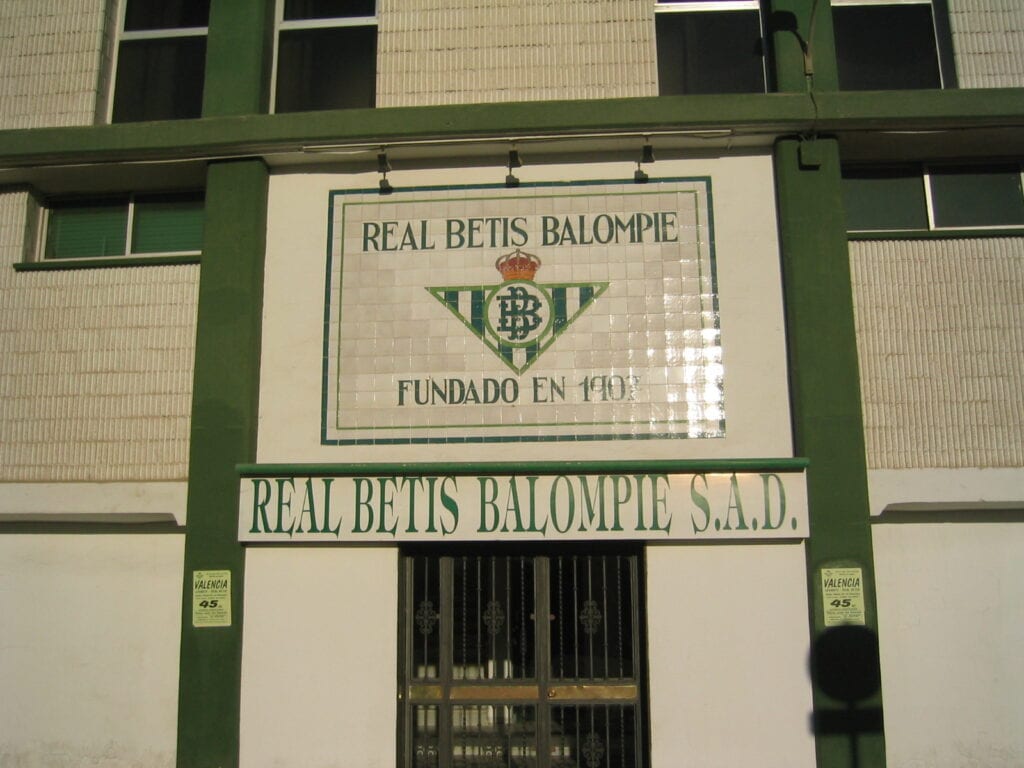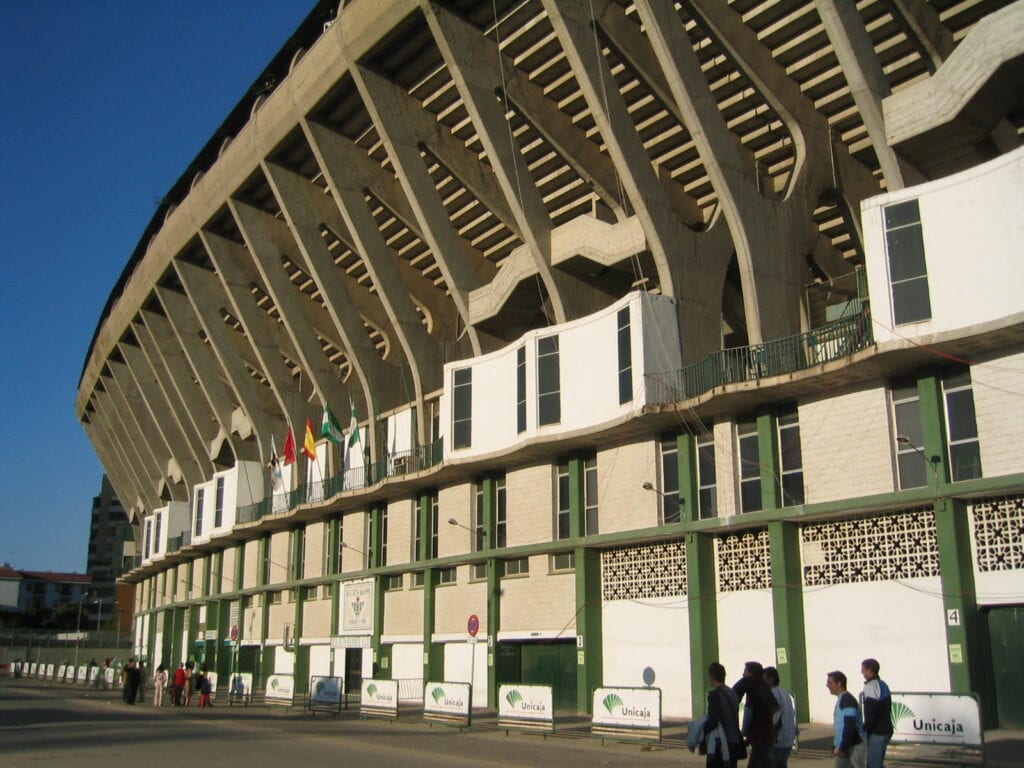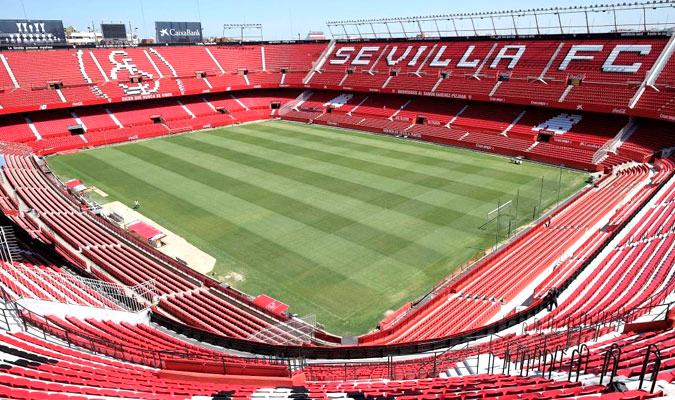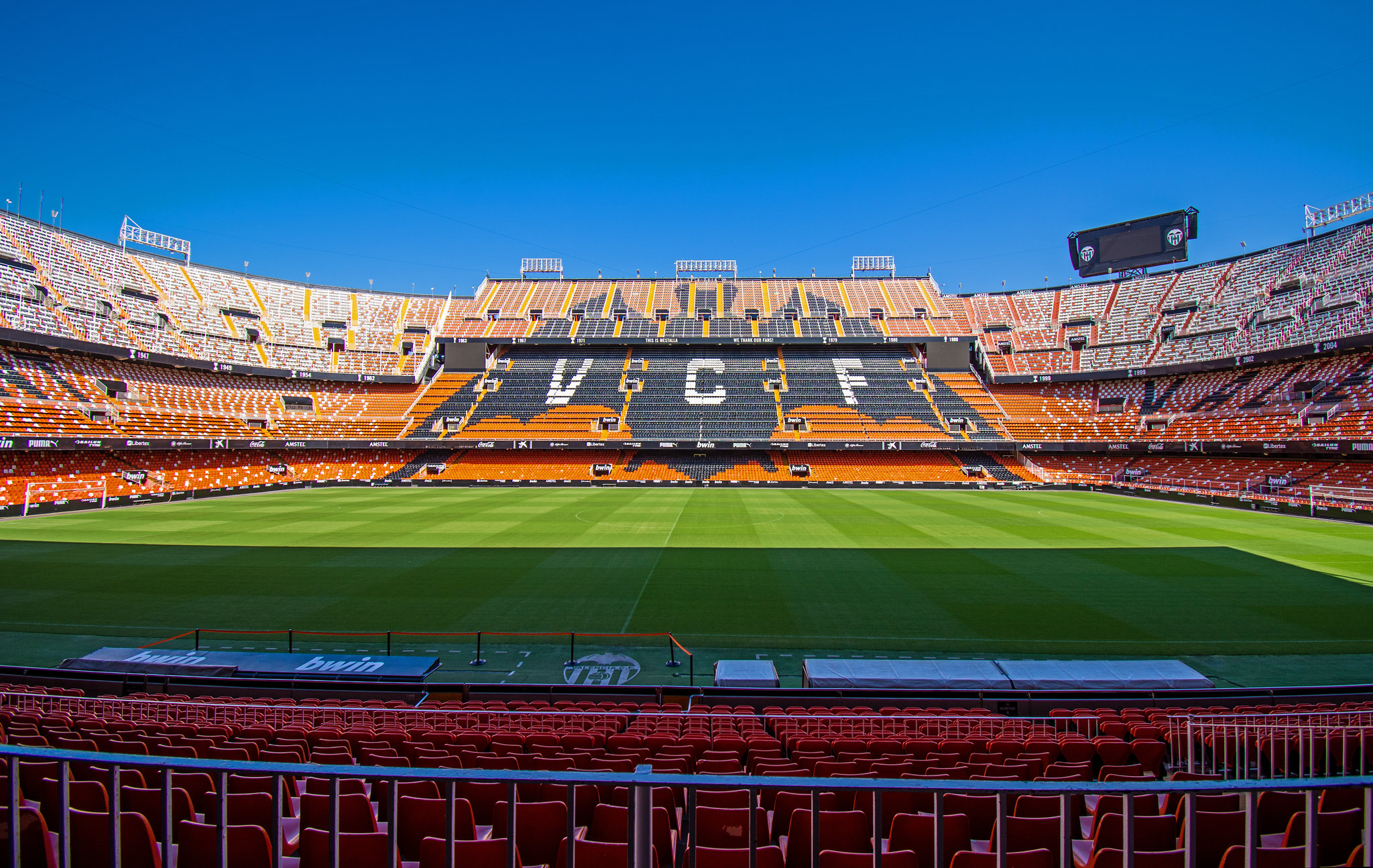In 1907 Sevilla Balompié was formed by students from the Escuela Politéchnica. A breakaway group from the older Sevilla FC formed a new club which they called Betis Football Club. This club merged with Sevilla Balompié in 1914 and was given royal patronage by King Don Alfonso XIII – becoming Real Betis Balompié. At that time Betis were playing in a set of green and black striped shirts given to them by Glasgow Celtic, which was later changed to the green and white of the Andalucía flag.
In recent times Real Betis haven’t experienced the same success as their illustrious neighbours Seville FC who have won six Europa League titles. However, support for Los Verdiblancos remains as passionate as ever. They did win the league way back in 1935 and captured the Copa del Rey in 1977. Since then they have appeared in the final of that competition twice, losing to Barcelona in 1997 and beating Osasuna to win the trophy in the 2004-05 season.

The word ‘Balompié’ is a variation of the literal Spanish translation of the word ‘football’.
The name ‘Betis’ is derived from word ‘Baetis’ which was the Roman name for Seville’s Guadalquivir River.
Seville Derby: The very first Seville derby between Real Betis and Sevilla FC took place in 1915, with Sevilla winning 4-3. Over the years this has proven to be one of the country’s most fiercely fought rivalries. Traditionally, Betis have always been seen as attracting their support from the working classes whilst Sevilla have had more aristocratic associations. This intense rivalry has at times spilt over into violent affairs but fortunately recent matches have been played in a resonably sporting atmosphere.
Real Betis Stadium

Real Betis play at the 60,720 seater Estadio Benito Villamarín in Seville which is one of the most passionate places to watch La Liga football in Spain. The stadium had been renamed Estadio Manuel Ruiz de Lopera in 1997 after the then-president of the club. However, in 2010 the Betis fans voted to again name the stadium Benito Villamarín in honour of the president who served the club from 1955 to 1965.
Getting There: Estadio Benito Villamarín lies on Avenida la Palmera, approximately 3km south of the historic centre of Seville, about 3 kilometres from the historic city centre. It’s a pleasant walk to get there which takes about 45 minutes from the centre. Buses #1 and 34 from the main Prado Bus Station run to the stadium. Other lines including #2, #6 and #37 stop near the stadium. Of course there are plenty taxis to take you to the stadium.
If you’d like to really travel in style you should hire a horse-drawn carriage to the match from near the Cathedral. I’ll never forget the site of hundreds of Liverpool fans heading up to the Real Betis stadium a few years ago for a Champions League clash travelling in these carriages.
Real Betis Stadium Tour
Football fans visiting Seville should take a tour of the Estadio Benito Villamarín and learn about the fascinating history of Real Betis Balompié. You can download a booking voucher to your mobile phone below.
Real Betis Fixtures 2023-24
| Provisional Date | Home Team | Away Team | Venue |
| 16/09/2023 | FC Barcelona | Real Betis | Estadi Olímpic Lluís Companys |
| 24/09/2023 | Real Betis | Cádiz CF | Estadio Benito Villamarín |
| 27/09/2023 | Granada CF | Real Betis | Nuevo Los Cármenes |
| 01/10/2023 | Real Betis | Valencia CF | Estadio Benito Villamarín |
| 08/10/2023 | Deportivo Alavés | Real Betis | Mendizorroza |
| 22/10/2023 | Getafe CF | Real Betis | Coliseum Alfonso Pérez |
| 29/10/2023 | Real Betis | CA Osasuna | Estadio Benito Villamarín |
| 05/11/2023 | Real Betis | RCD Mallorca | Estadio Benito Villamarín |
| 12/11/2023 | Sevilla FC | Real Betis | Ramón Sánchez-Pizjuán |
| 26/11/2023 | Real Betis | UD Las Palmas | Estadio Benito Villamarín |
| 03/12/2023 | UD Almería | Real Betis | Power Horse Stadium |
| 10/12/2023 | Real Betis | Real Madrid | Estadio Benito Villamarín |
| 17/12/2023 | Real Sociedad | Real Betis | Reale Arena |
| 20/12/2023 | Real Betis | Girona FC | Estadio Benito Villamarín |
| 03/01/2024 | RC Celta | Real Betis | Estadio ABANCA Balaídos |
| 14/01/2024 | Real Betis | Granada CF | Estadio Benito Villamarín |
| 21/01/2024 | Real Betis | FC Barcelona | Estadio Benito Villamarín |
| 28/01/2024 | RCD Mallorca | Real Betis | Estadi Mallorca Son Moix |
| 04/02/2024 | Real Betis | Getafe CF | Estadio Benito Villamarín |
| 11/02/2024 | Cádiz CF | Real Betis | Estadio Nuevo Mirandilla |
| 18/02/2024 | Real Betis | Deportivo Alavés | Estadio Benito Villamarín |
| 25/02/2024 | Real Betis | Athletic Club | Estadio Benito Villamarín |
| 03/03/2024 | Atlético de Madrid | Real Betis | Civitas Metropolitano |
| 10/03/2024 | Real Betis | Villarreal CF | Estadio Benito Villamarín |
| 17/03/2024 | Rayo Vallecano | Real Betis | Estadio de Vallecas |
| 31/03/2024 | Girona FC | Real Betis | Estadio Municipal de Montilivi |
| 14/04/2024 | Real Betis | RC Celta | Estadio Benito Villamarín |
| 21/04/2024 | Valencia CF | Real Betis | Camp de Mestalla |
| 28/04/2024 | Real Betis | Sevilla FC | Estadio Benito Villamarín |
| 05/05/2024 | CA Osasuna | Real Betis | Estadio El Sadar |
| 12/05/2024 | Real Betis | UD Almería | Estadio Benito Villamarín |
| 15/05/2024 | UD Las Palmas | Real Betis | Estadio Gran Canaria |
| 19/05/2024 | Real Betis | Real Sociedad | Estadio Benito Villamarín |
| 26/05/2024 | Real Madrid | Real Betis | Estadio Santiago Bernabéu |
Real Betis Tickets
Real Betis tickets for most games at the Estadio Benito Villamarín can be purchased at the stadium’s ticket windows (taquillas) behind the South Stand (Gol Sur). These ticket windows are open from Monday to Friday, 10am to 2pm and 5pm to 8pm. Tickets go on sale in the days leading up to the match and are usually available on matchdays.
It’s also worth checking the official Real Betis website as an online ticketing service has been in operation in recent seasons. Customers can print out an e-ticket which they receive by email. Some games against FC Barcelona, Real Madrid and Sevilla FC may sell out so advanced purchase is recommended.
History of Real Betis Balompié
Betis joined La Liga in the 1932-33 season and were immediately successful, winning the title in 1935 under Irish coach Patrick O’Connell. Unfortunately for Los Béticos, they have never been able to repeat the feat in the subsequent years.
Real Betis were unable to keep their league-winning team together due to desperate economic times tied in with the Spanish Civil War which forced the suspension of la Liga. When the league returned for the 1939-40 season Betis were immediately relegated and fell into the footballing wilderness which saw them slip to the third tier of Spanish football in 1947. During this dark period Betis still saw full stadiums for home games and a large following at away matches. It was 1954 before they returned to Second Division.
In 1955 the loyal chairman, Manuel Ruiz Rodríguez, who had helped steer Betis back to the 2nd tier of Spanish football was succeeded by Benito Villamarín. The new president led Betis back to the promised land of the first division in 1958–59 and bought the Estadio Heliópolis in 1961 which was named after him and remains so to this day. In 1966, just one year after Benito Villamarín stepped down from his post as club president, Betis were again relegated and spent five of the next eight seasons in the second division.
The 1974–75 season was pivotal in the history of Real Betis as it marked the season when the club established itself as a top tier football club. There have been six relegations since that year including the most recent in 2014 but are not quite the yo-yo club that they once were.

Real Betis in the 21st Century
In that 2004-05 season under Serra Ferrer, when Betis last won the Copa del Rey, they finished 4th in La Liga and qualified for the Champions League. This made them the first ever Andalucian team to do so although Sevilla FC and Malaga CF would follow suit in later years.. They made it to the group stage in which they beat Chelsea on a great European night in Seville but couldn’t progress any further.
Having stared relegation in the face on a number of occasions they finally succumbed at the end of the 2008–09 season. The club president, Manuel Ruiz de Lopera, was involved in an ongoing fraud saga that eventually culminated in popular ex-player Rafael Gordillo becoming the new president. After two seasons outside Spain’s top flight, Betis returned to La Liga in the 2011–12 season. They also returned to European competition in 2013-14, qualifying for the Europa League in which they suffered a painful quarter-final defeat on penalties to Sevilla FC. They were also relegated for a single season.
After a disappointing 15th place finish in the 2019-20 season, Betis began the following season with 39 year old Joaquín Sánchez Rodríguez as captain. he played his first game for Betis in the year 2000 then after six seasons moved on to Valencia, Malaga and Fiorentina before returning to Betis in 2015. Joaquín is a legend of a player who played 51 times for Spain and holds the recored for the most appearances in the history of Real Betis.
Useful Links:
Real Betis Official Website: The club’s website is the place to confirm match dates, kick-off times and ticket information.



